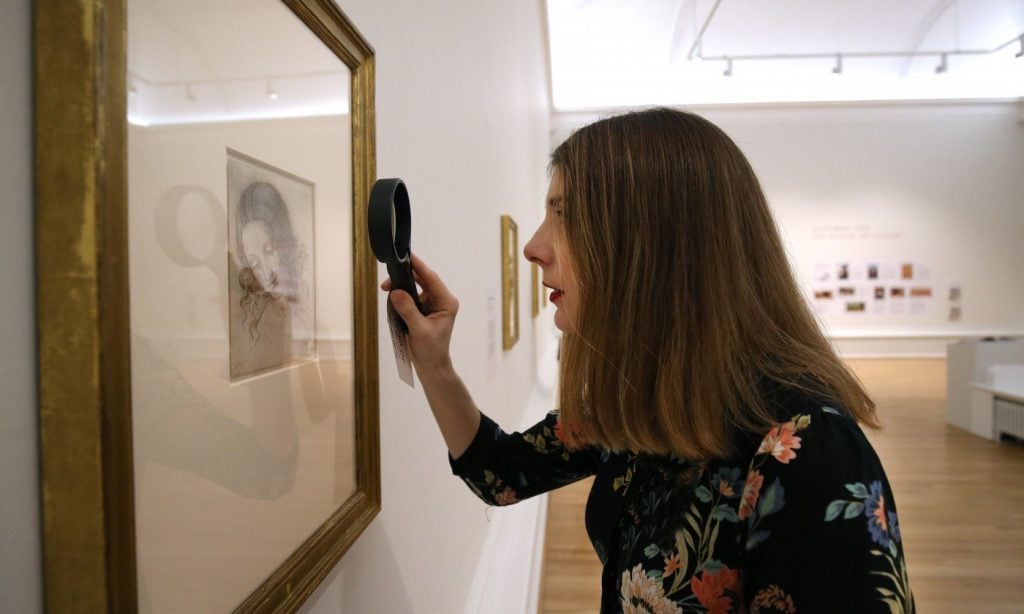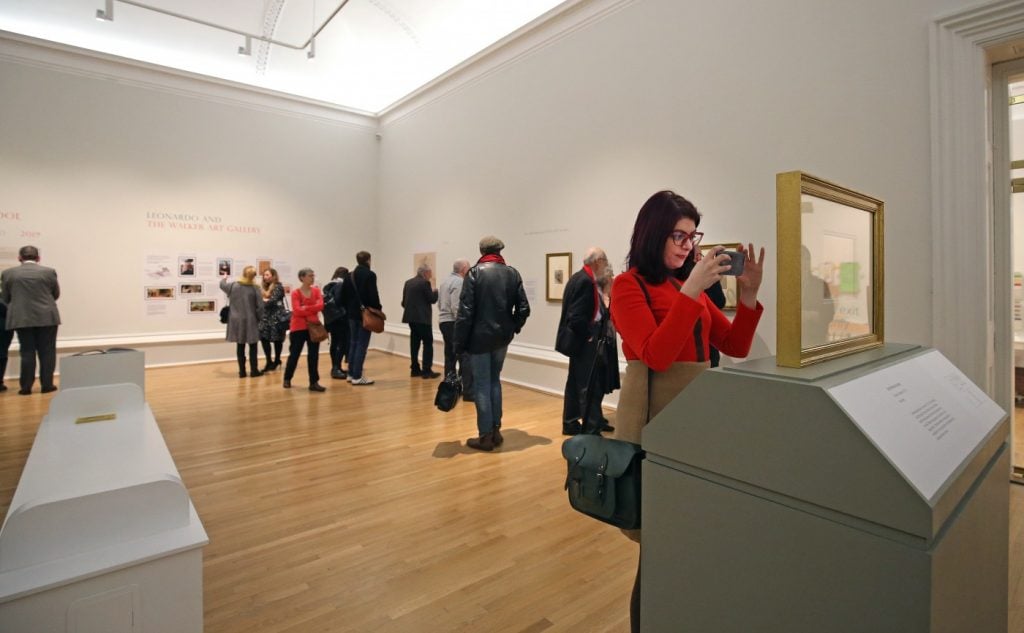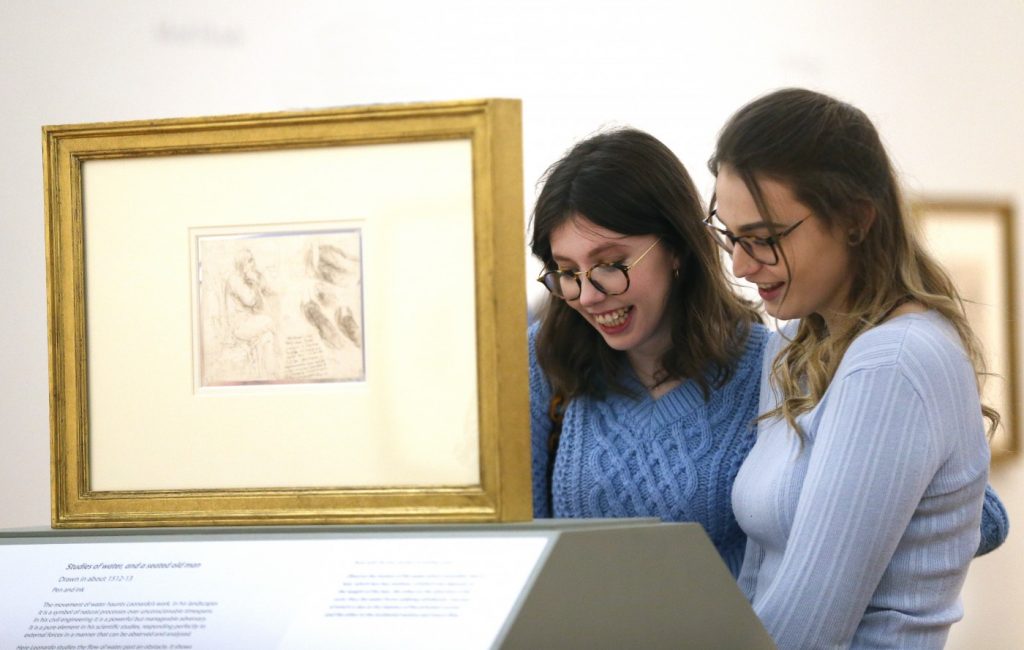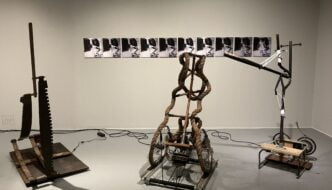
© Gareth Jones
The Queen owns a lot of art. She possesses over 30,000 watercolours and drawings alone. Contained within these works, hidden away in the Royal Collection, lie 600 drawings by Leonardo da Vinci. These treasures are hidden no longer as, thanks to the gracious generosity of Her Majesty, 144 of da Vinci’s ‘greatest’ drawings are currently being displayed across the country, twelve of them at the Walker Art Gallery in Liverpool.
One of the first drawings you come across is “The head of Leda”. It’s one of the more recognisable da Vinci drawings. At the centre of her sparsely detailed face, Leda’s countenance, like that of Mona Lisa, holds a striking mystery, that unravels as you observe the drawing and consider the myth of bestial love that defines the Spartan queen. But, here, we find none of the fear or reluctance of W. B. Yeats’ “Leda and the Swan”, but rather a woman completely poised and in control. The lack of detail in the face of Leda contrasts with her elaborate hairstyle; a confluence of chaos and order, patterns at one moment meticulous, then suddenly aleatory and random, braids weaving into braids, loose strands flicking in every direction like wispy flames. The hair of Leda is one of the moments in the exhibition when you truly get a feel for da Vinci’s mastery.
Another one of these moments comes from the startlingly lifelike essence of “The Drapery of Madonna’s Thigh”. This is one of only two drawings in the exhibition containing colour; a kind of indigo that emphasises the folds of the material covering the thigh. The vivid definition is created through a skilled use of shadow and light, giving the drawing the sense of a simple moment frozen in time, something fleeting made permanent. This drawing was a precursory study for the painting “The Virgin and Child with St. Anne”, where this form of lucid depiction achieves its telos. When viewing each work, it’s no wonder that, as Sigmund Freud asserts, da Vinci ‘appeared uncanny and incomprehensible to his contemporaries’.

© Gareth Jones
Looking at these genius sketches, seeing them displayed so matter-of-factly, so within reach, you might be overcome by the desire to inch your fingertips behind the picture frames to see if you can dislodge one of them from the wall and carry it away beneath your coat. God knows by what nefarious means the Queen came into possession of these priceless pieces, but walking around the small exhibition space, one cannot help but think how depressing it is that these works are contained within the private collection of a monarch, rather than permanently on display across the globe. Hopefully one day, when the revolution comes, we can set these artworks free, along with the hundreds of thousands of other treasures contained within the Royal Collection, of which only a measly 0.1% are displayed at any one time.
In the middle of the room two pages are displayed, not on the wall, but between sheets of glass, so you can see both sides of the paper, as da Vinci has drawn unrelated studies on each side. The almost throwaway quality of these pieces, the fact that they were clearly never intended to be exhibited, bestows upon them a profound significance.

© Gareth Jones
The most fascinating of the four sides of paper is called “A rearing horse, and heads of a horse, a lion and a man”, where each figure appears subtly removed from the aesthetics of reality, in jarring opposition to the realism of works like “The drapery of Madonna’s thigh”. The faces of the horses appear contorted and anguished, the flesh sagging as if melting off the delicate bones of the skull. These improvisational sketches feel closer to the more abstract da Vinci drawings, such as the monstrous ‘caricatures’, which are unfortunately not displayed within this exhibition. This is another reason why it feels wrong for the 144 drawings to be exhibited around the country in this scattered fashion; it’s impossible to get a rounded context of da Vinci’s artistry from such a narrow, seemingly random sample of his work.
The exhibition concludes with the vaguely unsettling “Apocalyptic scenes, with notes”. The page is dominated by several storms of fire, billowing smoke engulfing crumbling cities. Looking closer, it becomes clear that one of these fiery tempests is actually comprised of skeletal figures piled on top of one another in a fragmented mountain of limbs. Death and destruction screams off the page, but there is also a complex beauty present. A comparison could be drawn between the tangles of the smoky clouds and the braids of Leda’s hair. Both of these details hold the awesome intricacy and attentiveness for which da Vinci is held in such high esteem. But ”Apocalyptic scenes, with notes” shows another side of da Vinci, a darkness in the soul of a man coming to the end of his life, seldom so close to the surface in his more widely appreciated work.
Leonardo da Vinci: A Life in Drawing is on display at the Walker Art Gallery until the 6th of May. Find out more here.
Filed under: Art & Photography
Tagged with: da vinci, drawing, exhibition, Renaissance art, The Walker



Comments